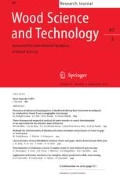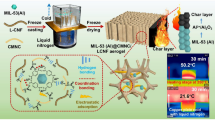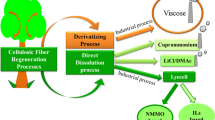Abstract
Poplar alkaline peroxide mechanical pulp (APMP) was used as plant fiber raw material, and it was graded according to the lignin content. The graded raw materials were used to prepare lignin-containing microfibers (LCMFs) by micro-grinding, and then, the lignin-containing microfiber cryogels (LCMF-cryogels) were prepared by vacuum freeze-drying. The particle size distribution, micromorphology and dispersion stability of LCMFs were characterized by laser diffraction particle size analyzer, transmission electron microscopy and Zeta potentiometer. Then, the crystalline structure, pore structure, surface morphology and adsorption properties of LCMF-cryogels were analyzed. In addition, LCMF-cryogels were compared with the microfiber cryogels (MF-cryogels) which use commercial eucalyptus chemical bleaching pulp as raw material. It was proved that using poplar APMP as raw material to prepare cryogels is more advantageous. The results showed that the lower the lignin content in plant materials, the better the oil adsorption ability of cryogels. This is because the binding effect of lignin on the fiber is reduced, which makes the fibrillation of the fiber easier by external mechanical action. The maximum adsorption capacity of LCMF-cryogel for methyl silicone oil is 215 g/g, while that of MF-cryogel prepared from commercial eucalyptus chemical bleaching pulp is 102.5 g/g. The analysis of the properties of raw fiber and the gel pores shows that the change in the fiber morphology caused by different pulping methods has important influence on the development of LCMF-cryogels by mechanical refining. Poplar APMP is more suitable for preparing fiber-based cryogels oil-absorbing materials than commercial eucalyptus chemical bleaching pulp.










Similar content being viewed by others
References
Angelova D, Uzunov I, Uzunova S, Gigova A, Minchev L (2011) Kinetics of oil and oil products adsorption by carbonized rice husks. Chem Eng J 172(1):306–311
Buchtova N, Budtova T (2016) Cellulose aero-, cryo-and xerogels: towards understanding of morphology control. Cellulose 23(4):2585–2595
Cao Y, Jiang YQ, Song YY, Cao SM, Miao M, Feng X, Fang JH, Shi LY (2015) Combined bleaching and hydrolysis for isolation of cellulose nanofibers from waste sackcloth. Carbohydr Polym 131:152–158
Cervin NT, Aulin C, Larsson PT, Wågberg L (2012) Ultra porous nanocellulose aerogels as separation medium for mixtures of oil/water liquids. Cellulose 19(2):401–410
Chen PC, Xu ZK (2013) Mineral-coated polymer membranes with superhydrophilicity and underwater superoleophobicity for effective oil/water separation. Sci Rep 3:2776
Chen LH, Zhu JY, Baez C, Kitin P, Elder T (2016) Highly thermal-stable and functional cellulose nanocrystals and nanofibers produced using fully recyclable organic acids. Green Chem 18(13):3835–3843
Choi HM, Cloud RM (1992) Natural sorbents in oil spill cleanup. Environ Sci Technol 26(4):772–776
Colson J, Amer H, Liebner F, Gindl-Altmutter W (2018) Oil-absorbing porous cellulosic material from sized wood pulp fines. Holzforschung 73(1):83–92
Darpentigny C, Nonglaton G, Bras J, Jean B (2020) Highly absorbent cellulose nanofibrils aerogels prepared by supercritical drying. Carbohydr Polym 229:115560
De France KJ, Hoare T, Cranston ED (2017) Review of hydrogels and aerogels containing nanocellulose. Chem Mater 29(11):4609–4631
Deschamps G, Caruel H, Borredon ME, BonninC Vignoles C (2003) Oil removal from water by selective sorption on hydrophobic cotton fibers. 1. Study of sorption properties and comparison with other cotton fiber-based sorbents. Environ Sci Technol 37(5):1013–1015
Feng J, Nguyen ST, Fan Z, Duong HM (2015) Advanced fabrication and oil absorption properties of super-hydrophobic recycled cellulose aerogels. Chem Eng J 270:168–175
Gupta RK, Dunderdale GJ, England MW, Hozumi A (2017) Oil/water separation techniques: a review of recent progresses and future directions. J Mater Chem A 5(31):16025–16058
He J, Zhao H, Li X, Su D, Zhang F, Ji H (2018) Superelastic and superhydrophobic bacterial cellulose/silica aerogels with hierarchical cellular structure for oil absorption and recovery. J Hazard Mater 346:199–207
Hoepfner S, Ratke L, Milow B (2008) Synthesis and characterisation of nanofibrillar cellulose aerogels. Cellulose 15(1):121–129
Ifuku S, Nogi M, Yoshioka M, Morimoto M, Yano H, Saimoto H (2010) Fibrillation of dried chitin into 10–20 nm nanofibers by a simple grinding method under acidic conditions. Carbohydr Polym 81(1):134–139
Kaya M (2017) Super absorbent, light, and highly flame retardant cellulose-based aerogel crosslinked with citric acid. J Appl Polym Sci 134(38):45315
Korhonen JT, Kettunen M, Ras RH, Ikkala O (2011) Hydrophobic nanocellulose aerogels as floating, sustainable, reusable, and recyclable oil absorbents. ACS Appl Mater Interfaces 3(6):1813–1816
Lim TT, Huang X (2007) Evaluation of kapok (Ceiba pentandra (L.) Gaertn.) as a natural hollow hydrophobic-oleophilic fibrous sorbent for oil spill cleanup. Chemosphere 66(5):955–963
Liu HZ, Geng BY, Chen YF, Wang HY (2017) Review on the aerogel -type oil sorbents derived from nanocellulose. ACS Sustain Chem Eng 5(1):49–66
Moore WE, Johnson DB (1967) Procedures for the chemical analysis of wood and wood products. US Department of Agriculture Forest products laboratory Forest Service, Madison
Nelson ML, O’Connor RT (1964) Relation of certain infrared bands to cellulose crystallinity and crystal lattice type. Part I. Spectra of lattice types I, II, III and amorphous cellulose. J Appl Polym Sci 8(3):1311–1324
Wan C, Lu Y, Cao J, Sun Q, Li J (2015) Preparation, characterization and oil adsorption properties of cellulose aerogels from four kinds of plant materials via a naoh/peg aqueous solution. Fibers Polym 16(2):302–307
Xia JY, Liu ZL, Chen Y, Cao YF, Wang ZG (2020) Effect of lignin on the performance of biodegradable cellulose aerogels made from wheat straw pulp-LiCl/DMSO solution. Cellulose 27(2):879–894
Xu M, Bao W, Xu S, Wang X, Sun R (2016) Porous cellulose aerogels with high mechanical performance and their absorption behaviors. BioResources 11(1):8–20
Zhang Z, Sèbe G, Rentsch D, Zimmermann T, Tingaut P (2014) Ultralightweight and flexible silylated nanocellulose sponges for the selective removal of oil from water. Chem Mater 26(8):2659–2668
Zhang TM, Zhang Y, Wang XY, Liu S, Yao Y (2018) Characterization of the nano-cellulose aerogel from mixing CNF and CNC with different ratio. Mater Lett 229(15):103–106
Zhang XW, Kwek LP, Le DK, Tan MS, Duong HM (2019) Fabrication and properties of hybrid coffee-cellulose aerogels from spent coffee grounds. Polymers 11(12):1942
Zheng Q, Cai Z, Gong S (2014) Green synthesis of polyvinyl alcohol (PVA)–cellulose nanofibril (CNF) hybrid aerogels and their use as superabsorbents. J Mater Chem A 2(9):3110–3118
Acknowledgments
The project supported by the National Key Research and Development Program of China (2017YFD0601005), the foundation (No. KF201803) of state key laboratory of biobased material and green papermaking, Qilu University of Technology, Shandong Academy of Sciences. The authors are also grateful for the support of the National Key Basic Research Program of China (Project No. 2018NFUSPITP670). The work was also supported by the Nanjing Forestry University Outstanding Youth Fund (NLJQ2015-5). The research did not receive any specific Grant from funding agencies in the public, commercial or not-for profit sectors.
Author information
Authors and Affiliations
Corresponding author
Additional information
Publisher's Note
Springer Nature remains neutral with regard to jurisdictional claims in published maps and institutional affiliations.
Rights and permissions
About this article
Cite this article
Zhang, H., Zhu, L., Xue, S. et al. Preparation of high oil absorption microfiber cryogels by mechanical method. Wood Sci Technol 54, 1363–1384 (2020). https://doi.org/10.1007/s00226-020-01218-w
Received:
Published:
Issue Date:
DOI: https://doi.org/10.1007/s00226-020-01218-w




